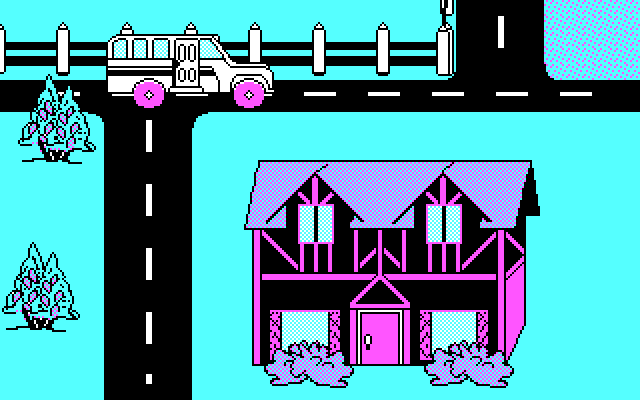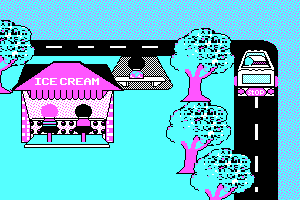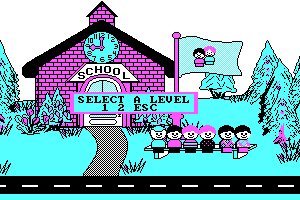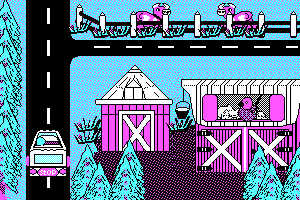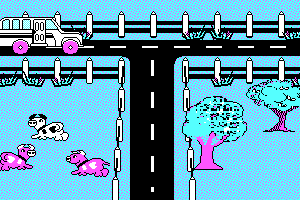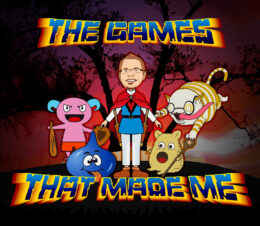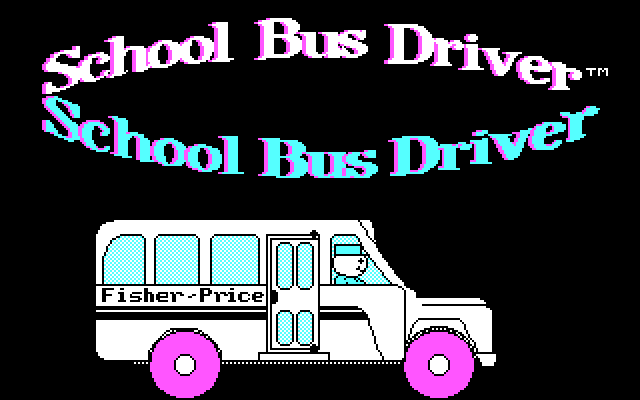“A game that inspired me to want to drive a school bus when I grew up.”
-Brendino
Fisher-Price: SChool Bus driver (1988, MS-DOS)
An Obsession WIth Bus Drivers
Quick: What was the first job you remember wanting to have when you grew up? Did you want to be an astronaut and explore the farthest reaches of the galaxy? Perhaps a career in the military was more your style, no doubt reinforced by some of the standard 80s and 90s kid’s toys like GI Joe figures, those ubiquitous little green army men, and Nerf guns. Or maybe you wanted a job that brought with it a lot of fame and/or fortune: actor/actress, musician, doctor, lawyer, etc. Back in my early elementary school days, long before I even thought about pursuing a career in teaching, TV weatherman, or a DJ on the radio, I had my sights set on an entirely different career path: school bus driver.

For those of us whose parents refused to drive them to and from school every day and who lived too far from the school to walk or ride a bicycle safely, we became intimately familiar with the world of the school bus. In the mornings, we were assigned a bus stop and expected to navigate there in time for the bus’s arrival. While on the bus, proper bus etiquette demanded that we stay seated, refrain from making too much noise, keep our personal area clean, and sit in our assigned seat. In the afternoons, we were expected to board our big yellow limousine on time and only to get off at our correct bus stop. When students followed these rules and procedures, our journey to and from school each day became just as routine as our time in the classroom. While most of my peers probably didn’t think twice about their morning and afternoon rides on the school bus, I became infatuated with it. To me, the job of a school bus driver was magical. They got to drive large, bright yellow buses around town, picking up and dropping off students multiple times each weekday. When things got too rowdy on the bus, they might raise their voices, threaten to pull the bus over, or even contact the school principal to meet the bus upon its arrival to school. What power and authority they seemed to have over their young passengers! Most fascinating to me were the neat contraptions school bus drivers got to use on a daily basis. They had red and white stop signs with flashing lights that swung out from the side of the bus. They used flashing lights on both the front and back of the bus that had the effect of being able to stop traffic in two directions. And who can forget the mechanism used to open and close the bus doors?
To be honest, I can’t really recall what it was about being a school bus driver that had such a powerful grip over me. Perhaps I simply liked the fact that the bus was painted a vibrant and distinctive shade of yellow, my favorite color. Maybe it was because the drivers always seemed to be in control, not only of the bus itself, but of every student on board. Or perhaps it was simply because buses were large vehicles with a lot of unique and cool features that were not found on cars and other vehicles.
Whatever the ultimate reason was for my obsession, I can remember transforming a large box in my basement into a makeshift school bus, complete with hand-drawn art on the side to make it look more like a real school bus. I added a dashboard toy to the inside of the box that had a plastic steering wheel, an ignition that served as the on/off switch, and most importantly, it made noises that simulated a vehicle accelerating and decelerating depending on the positioning of the gear shift. Outside of my makeshift school bus, because there wasn’t enough room inside, I placed my boom box and made sure that it was tuned to my favorite radio station. My stuffed animals would serve as my student riders, being unceremoniously forced into my bus box during boarding and thrown from it when I reached their bus stop. If they became too rowdy or did not listen to and follow my instructions, I would yell at them to behave or threaten to pull the school bus over. And miraculously, I did all this without being labeled insane or placed into counseling by my parents.
A Simulated Experience
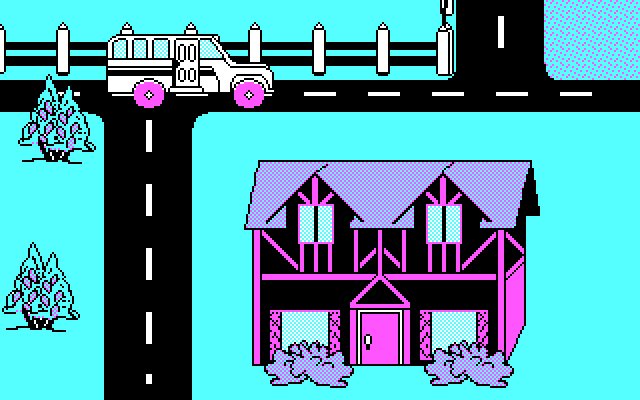
At some point during my infatuation with school buses, I was introduced to the computer game released by GameTek called Fisher-Price: School Bus Driver. This was a very rudimentary game clearly made for children in which you drove a school bus, picked up all of the Fisher-Price stylized children, and then dropped them off at school. There were only two “levels” available for this game, simply labeled 1 and 2. Level 1 was extremely simple, whereas Level 2 introduced blocked roadways that you had to contend with, forcing you to navigate to the bus stops in different ways. Overall, the gameplay was pretty simplistic, and there definitely was not much to the game itself. The town’s layout and the location of the school and bus stops were always the same. The player always picks up the same Fisher Price children from the same school bus, there being no way to upgrade or change the look of the school bus. By all accounts, this was not even one of GameTek’s major releases, as it is not even mentioned on their Wiki page. If the name GameTek sounds familiar to you, it is most likely because they owned the electronic publishing rights to the Jeopardy! and Wheel of Fortune franchises. And I am quite certain Fisher-Price: School Bus Driver did not catch on amongst young millennials and attract players in the same way that Flappy Bird did back in 2013.
While it would be easy to criticize Fisher-Price: School Bus Driver through our modern lens for its rudimentary graphics, simplified gameplay, or lack of features, we ironically live in an age where the same kind of overly-simplistic games DO have the potential to become popular and attract wide audiences. The mobile game market is saturated with examples of games designed with a less is more philosophy. One of the best examples of this is 2013’s Flappy Bird, a game in which the player simply taps the screen to make a bird fly through pairs of pipes. Each pair of pipes that you successfully navigate adds one point to the total score. The game is over only when the player causes the bird to crash into a pipe, and the player receives a total score for their efforts. This simple game would go on to gross $50,000 per day before being voluntarily pulled from app stores in February of 2014 by the developer.
I believe that if Fisher-Price: School Bus Driver was released today as a mobile game, it could have the potential to become a sleeper hit. Add increasingly difficult levels to the game, or simply make it an endless runner like Flappy Bird with the goal being to compete against yourself for the highest score. Allow different customization options for the school bus itself, perhaps different makes and models of buses that are progressively unlocked by the player. Include more diverse and varied communities to navigate, such as urban areas and rural locations. Insert a timer so that the player is rushing against the clock to deliver the students on time to their school. My final suggestion would be to add more elaborate hazards that the player would encounter, such as wildlife in the roadway, car accidents, road construction, and varying weather conditions.
ScreenShots:

